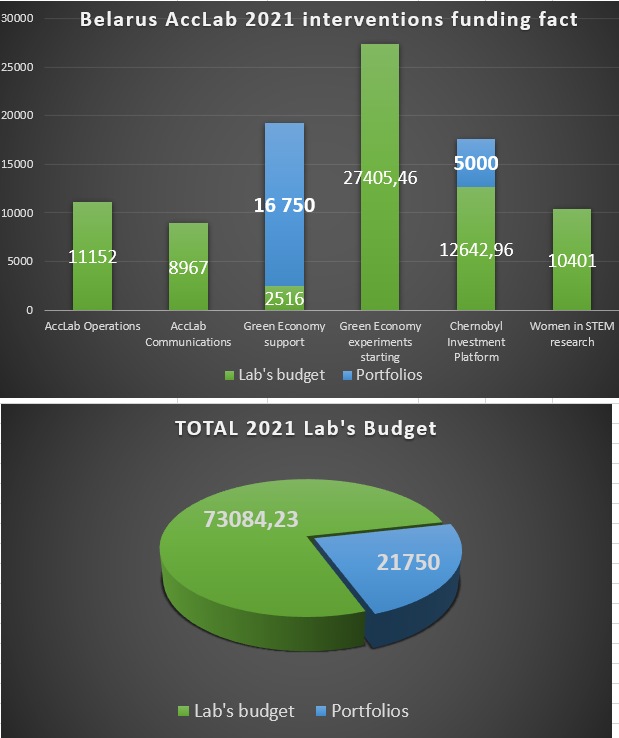Disclaimer:
Please be aware that the content herein has not been peer reviewed. It consists of personal reflections, insights, and learnings of the contributor(s). It may not be exhaustive, nor does it aim to be authoritative knowledge.
Learnings on your challenge
What are the top 5 key insights you generated about your frontier challenge during this Action Learning Plan?
Preliminary assessments (hypothesis) shows that Green Economy development affects more than 500 000 workplaces and can create additional 170 000 workplaces, which will be 14,2% of overall workforce which is 4 700 000 people. The Lab embedded UNDP into Green Economy processes in the country like never before - in the national strategic document. The National Action Plan on Green Economy [REDACTED_PHONE] was formulated with support of the Accelerator Lab, and contains 67 points, of which 17 points will be implemented with involvement of UNDP. Now UNDP's participation in Green Economy is an inseparable part of the national vision of green development. The Lab proposed, agreed and conducted all necessary actions to include Belarus into the Global Green Economy Index, and in March 2022 Belarus will be indicated in this global rating for the first time. The Lab spent 73084,23 USD on its activities, and additionally embedded its activities into other portfolios, and other portfolios allocated 21750 USD for the activities of the Lab. About 48% of the allocated funding the Lab spent of Green Economy as its Frontier Challenge.
Please paste the link(s) to the blog(s) that articulate the learnings on your frontier challenge.
Activities of the Belarusian Lab in 2021 were carried out in a difficult and sensitive political context, where 5 packages of sanctions were introduced, independent media and NGOs were liquidated. Hence, the communications unit of the CO kept the 'low profile' strategy with minimal written publications. The Lab's focus was shifted to production of videoclips and embedding mentioning of the Lab as an additional material within other topics and news. https://www-by-undp-org.translate.goog/content/belarus/ru/home/presscenter/pressreleases/proon-v-belarusi-zapuskaet-laboratoriyu-po-uskoreniyu-ustochivogo-razvitiya.html?_x_tr_sl=ru&_x_tr_tl=en&_x_tr_hl=ru&_x_tr_pto=wapp https://twitter.com/UNDP_Belarus/status/[REDACTED_PHONE] https://twitter.com/UNDP_Belarus/status/[REDACTED_PHONE] https://twitter.com/UNDP_Belarus/status/[REDACTED_PHONE] https://twitter.com/UNDPAccLabs/status/[REDACTED_PHONE] https://twitter.com/UNDP_Belarus/status/[REDACTED_PHONE] https://twitter.com/AaSolovieva/status/[REDACTED_PHONE]
Did you experience any barriers or bottlenecks when impacting the system, working on your frontier challenge respectively?
Barriers included shifting of the attention of governmental bodies from environmental to political agenda; suspending of operations of environmentally charged donors that supported the environmental agenda with events and publications like EU, NEFCO, EBRD, EDB; impossibility of mentioning of cooperation with EU in news and blogs, refusal of environmental experts and NGOs in working over green agenda with governmental bodies
For this frontier challenge, how much of your time did you dedicate to the stages in the learning cycle? Please make sure that your answers adds up to 100%.
Data and Methods
Relating to your types of data, why did you chose these? What gaps in available data were these addressing?
The main gap is that the NAP on Green Economy was prepared in a situation of aт interrupted dialogue between environmental and economic ministries, between ministries and civil society, between CSOs, academia and financial sector, between in-country and international organizations. And this lack of communication, coordination between different stakeholders was overcame with data. The Lab was taking data from one stakeholder and carried it to another one, because there were no direct communication. And methods of getting data were also different. Governmental bodies were ready to perceive only statistical data or surveys from academia, NGOs and civil society sector - only from social media or surveys. It was difficult, but became possible to bind different nodes of data collection and conversion in a way, where collective intelligence and participatory design is still possible during preparation of a strategic national document - NAP on GE [REDACTED_PHONE], covering difficult aspects of development of 14 sectors of economy.
Why was it necessary to apply the above innovation method on your frontier challenge? How did these help you to unpack the system?
Co-creation helped to unblock the dialogue between different stakeholders. Collective intelligence allowed to formulate the vision of Green Economy. Behavioral insights helped to understand to which extend people's behavior really decreases pollution and emission. Future analysis, horizon scanning, positive deviance and sensemaking were the methods of prediction of the future state of different sectors of green economy: green transport, forestry, organic agriculture, green education respectively. It became clear that there are no universal method suitable for the task of visualizing of future state of any green sector of economy, for each sector a separate method is needed. System thinking was used to built in the NAP on GE into the bunch of 25 state programs and SDG map. human centered design is an approach we used to test interventions before blogging about them or embedding them into the NAP.
Partners
If applicable, what civil society organisations did you actually work with and what did you do with them?
NGO "Green Economy", Mosty District NGO "Belarusian Society of the Disabled", NGO "Minsk Bicycle Club", NGO "APB-Birdlife"
If applicable, what academic partners (and related institutions) did you actually work with and what did you do with them?
National Academy of Sciences, Institute of Economy, Institute of Experimental Botany, Belarusian National Technological Institute, Polesye State Institute, Gomel State Institute, Minsk Oblast Institute of Development of Education. With these institutes we were conducting brainstorming sessions to formulate a vision of Green Economy of Belarus for [REDACTED_PHONE], preparing analytical reports, conducting different types of analysis. CNTDI - was engaged as a professional company that works with technology transfer.
If applicable, what private sector partners did you actually work with and what did you do with them?
Private Institute of Management and Entrepreneurship, consulting agencies UNITER, ASER, FBK-Bel - with these companies we were developing basics of green consulting regulation in Belarus and were exploring different methods of green growth monitoring and green bonds issuing. Private companies BVT, Belarusian Glass Company, Clean Shore - with these companies we were exploring and mapping different clean and green and circular technologies to identify those of them that worth to be included into in-country catalogue and get access to financial support while scaling up.
If applicable, what government partners (and related institutions) did you actually work with and what did you do with them?
Ministry of Natural Resources and Environmental Protection - green and circular economy regulation and promotion, Global Green Economy Index introduction. Ministry of Education - green economy promotion for youth, green education, Ministry of Economy - green and circular economy assessment, Ministry of Communication and Informatization - smart cities and digital infrastructure
Relating to your answers above: who of the partners listed were new and unusual partners for UNDP, and what made them special?
Institute of Economy for the first time was engaged for the assessment of the Chernobyl topic. Polesye and Gomel State Universities were engaged as supporting points in development of Chernobyl investment platform, CNTDI was the first organization that do technology transfer, UNITER, ASER, FBK-Bel for the first time were engaged to raise a new topic of green consulting. Ministry of Communication and Informatization was the new ministry for UNDP
End
Bonus question: How did the interplay of innovation methods, new forms of data and unusual partners enable you to learn & generate insights, that otherwise you would have not been able to achieve?
it helped to overcome the situation when key national partners don't communicate with each other directly, and avoid international contacts. Interplay of different methods of getting and presenting data allowed to establish an indirect dialogue by reading reports of each other. Thus, the preparation of a collective document like National Action Plan on GE [REDACTED_PHONE] was not suspended, olny slowed down. Inclusion of unusual partners - academia - allowed to formulate better strategic vision of what kind of green economy we want. Inclusion of consulting companies raised an issue of necessity to boost the green consulting sector, and inclusion of IFIs raised an issue of shirt term lack of green financing, which can only be covered through international banks. Joining the Global Green Economy Index helped to promote the in-country ESG-ratings and unblocked possibilities for many rating agencies in Belarus.
Please upload any further supporting evidence / documents / data you have produced on your frontier challenge that showcase your learnings.
Please see our learning journal https://sway.office.com/G6GFxPVmz5O3taic



 8Decent work and economic growth
8Decent work and economic growth 9Industry, innovation and infrastructure
9Industry, innovation and infrastructure 11Sustainable cities and communities
11Sustainable cities and communities
Comments
Log in to add a comment or reply.